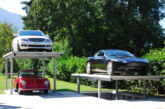Chris Meek, Specification Manager at Saint-Gobain Weber, explains which external finishes can help address the issues presented in different environments, as well as sharing some of his tips for working in the winter.
According to the Met Office, winters in the UK will be up to 30% wetter by 2070. While this seems a long time away, the homes being built now should long outlive this date and in order to do this, housebuilders and developers need to consider how the products they are specifying for the exterior of the property will help this.
External finishes
Render is one of the most flexible options for exteriors and allows housebuilders to achieve an attractive and durable finish. Render can be used to create a range of finishes including scraped, roughcast or dry dash as well as features such as ashlars and quoins.
For properties in areas of high exposure, dry dash – also known as pebble dash or harling – is often a popular choice.
A great example of dry dash in use is on a 168-home Barratt Homes development near Inverness. As one of the northernmost points of the British Isles, Inverness can be a place of weather extremes.
While dash is commonly used to give an extra layer of protection, traditional multi-coat dashing products typically take up to seven days to cure. This slows the housebuilding process and increases the cost.
After researching properties in the local area, Kevin Urquhart, construction director for Barratt Homes North, was impressed with the ‘standout’ finish of some new homes. Further investigation revealed they had been finished with weberend one coat dash; a one coat render that can receive a dry dash finish without the need to apply a second pass.
After verifying the claims of faster application and versatility with applicators who had first-hand experience of using the product, Kevin decided to specify it at Culloden West to reduce the building programme by approximately two days per plot.
Another benefit of using weberend one coat dash is that because it only requires one coat of render, developers can optimise any good weather days to reduce scaffold times and complete builds quicker.
Application depths
Depth of application is also important for longevity when up against the elements. Thickness requirements are impacted by location, orientation and exposure to wind and rain. The recommended thickness for sheltered to moderate exposure is 15mm and in more severe environments, such as coastal properties, this increases to 20mm.
The type of cavity wall insulation also has an impact. For a full fill cavity, the render must be thicker to provide two lines of defence against water infiltration.
Working in damp conditions
Working in wet weather can affect the texture and consistency of a render finish. If it is excessively wet, it can also degrade the bond and adhesion which could lead to serious problems.
Do not apply render during rainfall or when it is anticipated during the initial set. Render is susceptible to damage within the first 24 hours of application and must be protected in adverse weather conditions.
Winter working
When it comes to working in the winter, do not apply products in frosty conditions and always look at the minimum application temperature on the product packaging.
It is recommended that you check the temperature of the substrate before commencing work. Even if it’s 5°C outside when you are applying, the temperature could have been sub-zero a few hours previous and so the substrate is likely to still be frozen.
If the substrate is damp and the moisture freezes, the render will not adhere correctly. Protecting the substrate can help save days on site waiting for the weather to warm up to dry out the surface. Tenting the scaffolding or the use of mesh and cloths will help with this.
Rendering in cold weather can create lime bloom and while this doesn’t diminish the integrity or strength of the product, it can affect the aesthetics so protect your new finish using suitable materials.
Topcoats and decorative finishes can also be affected as cold conditions make drying slow as they rely on the evaporation of moisture within the product to set. Always follow the product’s guidance on this.
Beating the chill
With some products, an accelerator can be used at mixing stage which will speed up the initial set time. A product such as weber accelerateur monocouche can be used to reduce the time of scrape for through-coloured monocouche renders when working in temperatures as low as 5°C in the winter. If added at the correct dosage, it will achieve 20°C scrape time when working at 5°C.
My final tip for working in the cold is to ensure materials are protected from the elements or that they are moved to a location that is heated or warmed prior to mixing and application so that contractors can get on site and deliver a high-quality finish, first time.






